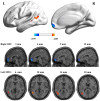Brain Functional Alternations of the Pain-related Emotional and Cognitive Regions in Patients with Chronic Shoulder Pain
- PMID: 32256105
- PMCID: PMC7093095
- DOI: 10.2147/JPR.S220370
Brain Functional Alternations of the Pain-related Emotional and Cognitive Regions in Patients with Chronic Shoulder Pain
Abstract
Objective: Chronic shoulder pain (CSP) is a common health problem associated with shoulder dysfunction and persistent pain for many different reasons. However, the studies of pain-related functional brain regions in CSP have been poorly investigated. The main purpose of our study was to observe whether there are abnormal functional changes in brain regions in patients with CSP by using functional magnetic resonance imaging (fMRI).
Patients and methods: We compared the differences of brain regions between 37 patients with CSP and 24 healthy controls (HC) using regional homogeneity (ReHo) method. The patients with chronic shoulder pain and healthy controls were matched for age and gender. Brain regions which had abnormal ReHo values were defined as seed region of interests. The approach of seed-based functional connectivity (FC) was further performed to analyze the connectivity between the seeds and whole brain regions. The relationship between abnormal regions and current clinical pain was also evaluated.
Results: Compared to healthy controls, the patients with CSP showed increased ReHo values in the left middle temporal gyrus and decreased ReHo values in right orbitofrontal cortex (OFC). The seed-based analyses demonstrated decreased connectivity between the right OFC and right rectus, superior frontal gyrus in patients with chronic shoulder pain. However, a correlation between ReHo values and clinical characteristics in CSP patients was not found.
Conclusion: The observed results indicate that there are abnormal ReHo values in brain regions of patients with CSP, especially in the OFC and middle temporal gyrus. Our findings demonstrate that the experience of CSP patients may be mainly associated with cognitive-affective pain processing, rather than nociception.
Keywords: chronic shoulder pain; cognition; emotion; functional magnetic resonance imaging.
© 2020 Li et al.
Conflict of interest statement
All authors declare no conflicts of interest in this work.
Figures


Similar articles
-
[Regional homogeneity in the patients of irritable bowel syndrome complicated with depression: a resting-state functional magnetic resonance imaging study].Zhonghua Yi Xue Za Zhi. 2018 Jan 16;98(3):196-201. doi: 10.3760/cma.j.issn.0376-2491.2018.03.008. Zhonghua Yi Xue Za Zhi. 2018. PMID: 29374914 Chinese.
-
Alterations in Regional Homogeneity Assessed by fMRI in Patients with Migraine Without Aura.J Med Syst. 2019 Jul 27;43(9):298. doi: 10.1007/s10916-019-1425-z. J Med Syst. 2019. PMID: 31352647
-
Aberrant Brain Regional Homogeneity and Functional Connectivity in Middle-Aged T2DM Patients: A Resting-State Functional MRI Study.Front Hum Neurosci. 2016 Sep 27;10:490. doi: 10.3389/fnhum.2016.00490. eCollection 2016. Front Hum Neurosci. 2016. PMID: 27729856 Free PMC article.
-
[Diffusion tensor imaging and resting-state functional magnetic resonance imaging in patients with delirium in intensive care unit].Zhonghua Wei Zhong Bing Ji Jiu Yi Xue. 2020 Jan;32(1):88-93. doi: 10.3760/cma.j.cn121430-20190905-00016. Zhonghua Wei Zhong Bing Ji Jiu Yi Xue. 2020. PMID: 32148238 Chinese.
-
[Mind-regulating and spleen-strengthening needling technique improves abdominal hypersensitivity and emotion by enhancing functional connectivity between hippocampus and brain regions in diarrhea-predominant irritable bowel syndrome patients].Zhen Ci Yan Jiu. 2021 Apr 25;46(4):318-25. doi: 10.13702/j.1000-0607.200569. Zhen Ci Yan Jiu. 2021. PMID: 33931998 Chinese.
Cited by
-
Brain Morphological and Functional Changes in Adenomyosis with Pain: A Resting State Functional Magnetic Resonance Imaging Study.J Clin Med. 2022 Sep 7;11(18):5286. doi: 10.3390/jcm11185286. J Clin Med. 2022. PMID: 36142933 Free PMC article.
-
Alterations in degree centrality and functional connectivity in tension-type headache: a resting-state fMRI study.Brain Imaging Behav. 2024 Aug;18(4):819-829. doi: 10.1007/s11682-024-00875-w. Epub 2024 Mar 21. Brain Imaging Behav. 2024. PMID: 38512647 Review.
-
Not Only in Sensorimotor Network: Local and Distant Cerebral Inherent Activity of Chronic Ankle Instability-A Resting-State fMRI Study.Front Neurosci. 2022 Feb 7;16:835538. doi: 10.3389/fnins.2022.835538. eCollection 2022. Front Neurosci. 2022. PMID: 35197822 Free PMC article.
-
Non-Surgical and Rehabilitative Interventions in Patients with Frozen Shoulder: Umbrella Review of Systematic Reviews.J Pain Res. 2022 Aug 19;15:2449-2464. doi: 10.2147/JPR.S371513. eCollection 2022. J Pain Res. 2022. PMID: 36016536 Free PMC article. Review.
-
Structural and Functional Asymmetry in Precentral and Postcentral Gyrus in Patients With Unilateral Chronic Shoulder Pain.Front Neurol. 2022 Feb 17;13:792695. doi: 10.3389/fneur.2022.792695. eCollection 2022. Front Neurol. 2022. PMID: 35250808 Free PMC article.
References
LinkOut - more resources
Full Text Sources

